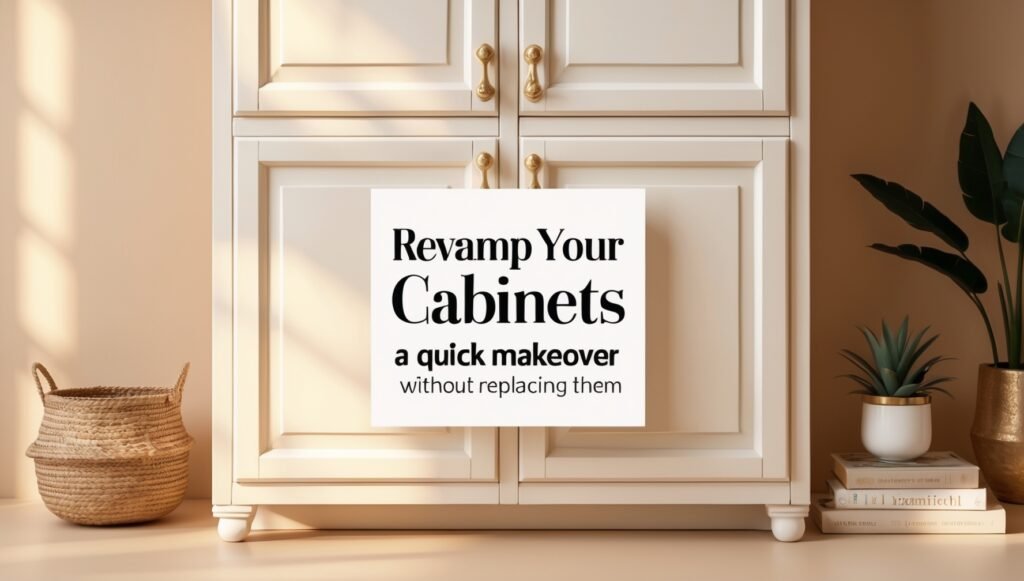
Welcome back to FixItSmartly.com! If you’re looking to give your kitchen or bathroom a fresh look without the hefty cost of replacing your cabinets, you’re in the right place. A cabinet makeover can completely transform your space and give your home a more modern feel without breaking the bank. Whether you’re updating old cabinetry or simply looking for a change, this quick DIY project is both affordable and achievable.
In this blog, we’ll walk you through the steps to revamp your cabinets, from sanding to painting, and offer you tips on how to add that extra touch of elegance with new hardware. By the end of this post, you’ll have the know-how to give your cabinets a fresh look and breathe new life into your kitchen or bathroom. Let’s get started!
Why Revamping Cabinets is a Smart Choice
Replacing cabinets can be expensive, especially if you’re renovating a complete kitchen or bathroom. Instead of spending a fortune on brand-new cabinets, why not give your existing ones a makeover? Not only does this save you money, but it’s also a great way to customize your space to match your style.
With the right tools, materials, and a little patience, you can completely transform your cabinets, making them look just as good as new—if not better!

Step 1: Remove Cabinet Doors and Hardware
The first step in revamping your cabinets is to remove the cabinet doors and any hardware, such as knobs or handles. This allows you to get to work on the surfaces with no obstacles in your way.
What You’ll Need:
Drill (if necessary)
Ziploc bags (for keeping track of screws and hardware)
Carefully unscrew the hinges from the doors and set them aside in a safe place. Be sure to label or store the screws with the hardware to ensure you don’t lose them. If your cabinets have removable shelves, now’s the time to take them out as well.
Step 2: Sand the Cabinet Surfaces
Next, you’ll want to send the surfaces of your cabinets to remove any old finish or imperfections. This will help the primer and paint stick to the surface better, giving you a smoother, more professional-looking finish.
What You’ll Need:
Sandpaper (medium and fine grit)
Sanding block or electric sander
Dust mask
Start with medium-grit sandpaper and lightly sand the cabinet doors and frames to remove the old paint or varnish. Follow up with fine-grit sandpaper for a smoother finish. Don’t forget to sand any corners or edges, as well as any hard-to-reach spots. Once you’ve finished sanding, wipe the surfaces clean with a damp cloth to remove all dust.
Pro Tip: If you’re short on time, consider using a premium sanding tool like the Power Sander Kit, which can make the job faster and easier!

Step 3: Apply Primer
Once your cabinets are sanded and clean, it’s time to apply a coat of primer. Primer is important because it helps the paint adhere better and ensures that the color stays vibrant for a longer period. Be sure to choose a primer that is suitable for the type of paint you plan to use.
What You’ll Need:
Primer (oil-based or water-based)
Paintbrush or roller
Drop clothes
Use a paintbrush or roller to apply a thin, even layer of primer to the cabinet surfaces. Let it dry completely before moving on to the next step. This usually takes a few hours, depending on the type of primer and the weather.
Pro Tip: If you’re using an oil-based primer, have proper ventilation in the room and wear a mask to avoid inhaling fumes.
Step 4: Paint Your Cabinets
Now comes the fun part—painting! Choose a high-quality paint that’s durable and designed for cabinets. You can go with a matte, satin, or glossy finish depending on your preference. Light colors can brighten up a space, while darker tones can create a more dramatic, elegant look.
What You’ll Need:
Paint (latex or oil-based)
Paintbrushes (angled brushes work best for edges)
Foam rollers
Using an angled paintbrush, start painting the edges and corners of the cabinet doors and frames. Then, use a foam roller to fill in the larger areas. Apply thin, even coats and allow each coat to dry completely before applying the next one. Depending on the color, you may need two or more coats.
Pro Tip: If you’re unsure about your paint skills, consider checking out our DIY painting guide in Repair It Right: Mastering Home Fixes for the Everyday Adult, which can give you tips and tricks for a flawless finish.

Step 5: Reattach the Hardware and Cabinet Doors
Once your paint is completely dry, it’s time to reattach the hardware and cabinet doors. This step is simple but makes a huge difference in the last look of your cabinets.
What You’ll Need:
New hardware (optional)
Screwdriver
If you want to give your cabinets a more modern or polished look, consider replacing the old knobs and handles with something fresh and stylish. Popular options include sleek modern pulls, vintage-inspired knobs, or even bold handles. Once you’ve chosen your hardware, simply screw the knobs or handles back onto the doors.
Now, reattach the cabinet doors to their frames using the screws you removed earlier.
Bonus Tip: Add Decorative Touches
For an extra flair, consider adding some decorative touches to your cabinets. You can apply a decorative glaze to the paint, or add some custom stencils or decals to the doors for a personal touch. This is also a great time to add new lighting to your cabinets or underneath the kitchen cabinets to brighten up the space.
Pro Tip: You can find some great inspiration and ideas for adding finishing touches to your cabinets in our The Handy Homeowner’s Guide, available now.
Revamping Cabinets is a Simple, Affordable Project
Revamping your cabinets is one of the most effective ways to update your home without spending a fortune. With just a little of time and effort, you can completely transform the look of your kitchen or bathroom, making it feel fresh, modern, and more functional. Whether you’re going for a sleek, contemporary look or a more rustic, farmhouse vibe, this DIY project allows you to customize your space exactly the way you want it.
If you’re ready to tackle more home improvement projects, don’t forget to check out our other helpful guides, including Fix It Before It Breaks: A DIY Prevention and Repair Handbook, and take your DIY skills to the next level.
Thanks for reading, and happy renovating!
FixItSmartly.com helps everyday people save money and build confidence by tackling home and car repairs with easy, practical DIY solutions. Live smart, safe, and self-reliant — one fix at a time.
Copyright © 2025 Fixitsmartly